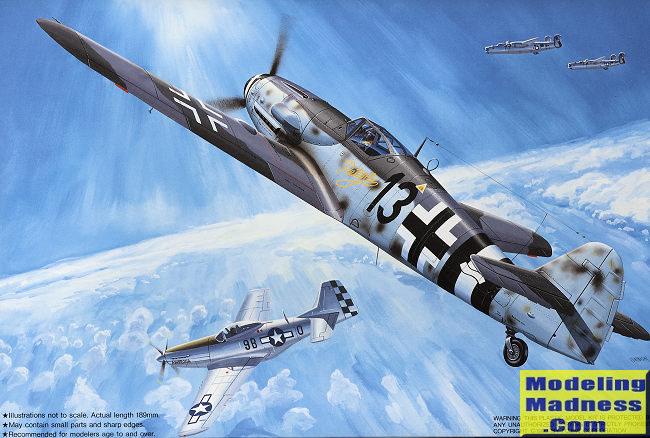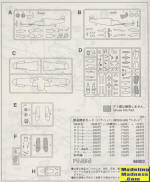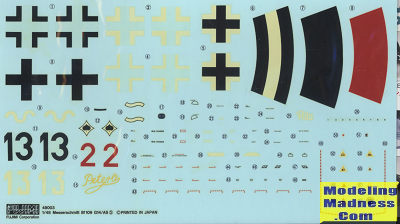
Fujimi 1/48 Bf-109G-14/AS
| KIT #: | 48003 |
| PRICE: | $35.00 MSRP when new (2200 yen in Japan) |
| DECALS: | Three options |
| REVIEWER: | Scott Van Aken |
| NOTES: | Includes resin and photo etched parts |

| HISTORY |
The G-14 arrived in July 1944 at the invasion front over France. It represented an attempt to create a standard type, incorporating many changes which had been introduced during production of the G-6, and which led to a plethora of variants, plaguing decentralized mass production. The standardization attempt proved to be a failure, but overall the type offered improved combat performance, as MW 50 power boosting water injection (increasing output to 1,800 PS (1,775 hp, 1,324 kW), the clear-view Erla Haube was now standard installation. Top speed was 568 km/h (353 mph) at sea level, and 665 km/h (413 mph) at 5 km (16,400 ft) altitude. A high-altitude fighter, designated G-14/AS was also produced with the DB 605ASM high-altitude engine. The ASM engine was built with a larger capacity supercharger, and had a higher rated altitude, and correspondingly the top speed of the G-14/AS was 560 km/h (348 mph) at sea level, and 680 km/h (422 mph) at 7.5 km (24,600 ft) altitude.
There was increasing tendency to use plywood on some less vital parts e.g. on a taller fin/rudder unit, pilot seat or instrument panel. A cautious estimate based on the available records suggest that about 5,500 G-14s and G-14/AS were built.
| THE KIT |
 Hasegawa
released their first 'round wing' 109 in 1991, starting with the F series. This
went on for several years and included the early G-2 aircraft, which used pretty
much all the F sprues. It wasn't until 1996 that they finally did a G-5/6
series. Meanwhile, in 1993, Fujimi released their K-4, G-6, and G-14 series,
providing variants that Hasegawa would not match for many years. Unfortunately
for US buyers, the US importer, MRC, felt that they could gouge US customers and
so were asking $35-40.00 for a kit that sold for 2200 yen in Japan (which at the
time was about $20.00. Still higher than the Hasegawa kits, but not that much
higher.
Hasegawa
released their first 'round wing' 109 in 1991, starting with the F series. This
went on for several years and included the early G-2 aircraft, which used pretty
much all the F sprues. It wasn't until 1996 that they finally did a G-5/6
series. Meanwhile, in 1993, Fujimi released their K-4, G-6, and G-14 series,
providing variants that Hasegawa would not match for many years. Unfortunately
for US buyers, the US importer, MRC, felt that they could gouge US customers and
so were asking $35-40.00 for a kit that sold for 2200 yen in Japan (which at the
time was about $20.00. Still higher than the Hasegawa kits, but not that much
higher.
If you have built a Hasegawa 109G, you will find much of this kit to be similar. The cockpit has an equivalent engineering and parts, the upper cowling is two parts. Exhaust can be installed after the airframe is painted. Prop is with separate blades, wing is single lower and two upper halves with radiators that are inserted prior to assembly. As the kit can be build with either standard or wider wheels you have a choice of wheel clearance bulges for the upper wings. Separate flaps and radiator exhaust doors are provided as well as separate slats. Under the wings you have a drop tank for the centerline and either 21 cm rockets or gun pods for the outer portions of the wing. Note that the small indentations for these are already in place for the outer wing stores so if going with clean wings you may have to fill these. Holes for the Morane antenna and centerline rack need to be opened.
 Markings are
provided for three planes. One is the box art plane from 14./JG 4. Also provided
are 2./JG 300 and 13./JG 53 aircraft. all are in a similar paint scheme of RLM
74/75/76. However, they may also be in a late war scheme that includes the more
brownish shade in place of the darker grey. The kit painting guide shows ALL of
the exterior paints needing mixed from Gunze paint. When I built my G-14/AS some
20+ years ago, I used RLM 81/82/76. Decals are nicely printed and while the
whites are a bit off-white, they appear to be usable. One thing about
well-stored Japanese kit decals is that they often will respond positively with
hot water, even after decades. Fortunately, finding replacement Luftwaffe
insignia is not difficult.
Markings are
provided for three planes. One is the box art plane from 14./JG 4. Also provided
are 2./JG 300 and 13./JG 53 aircraft. all are in a similar paint scheme of RLM
74/75/76. However, they may also be in a late war scheme that includes the more
brownish shade in place of the darker grey. The kit painting guide shows ALL of
the exterior paints needing mixed from Gunze paint. When I built my G-14/AS some
20+ years ago, I used RLM 81/82/76. Decals are nicely printed and while the
whites are a bit off-white, they appear to be usable. One thing about
well-stored Japanese kit decals is that they often will respond positively with
hot water, even after decades. Fortunately, finding replacement Luftwaffe
insignia is not difficult.

| CONCLUSIONS |
Fujimi never did do any 109s older than the G-6 version, leaving the early G and the E/F variants to Hasegawa. But when these kits were released, aside from the Otaki 109G-6, Revell G-10, and their own earlier tooling 109G/K kit which tried to be all variants in one box (and it didn't work out too well), these were it for accurate late war 109s. The kits build fairly well and while the detailing is not as petite as that provided by Hasegawa, the end result is still a very nice model. These have not disappeared, but some on-line sellers are asking stupid prices for this boxing.
| REFERENCES |
https://en.wikipedia.org/wiki/Messerschmitt_Bf_109_variants#Late-production_G-6,_G-14,_G-14/AS
April 2021
Copyright ModelingMadness.com. All rights reserved.
Thanks to
for the preview kit. You can find this kit at your favorite hobby shop
or on-line retailer. If you would like your product reviewed fairly and fairly quickly, please
contact
the editor or see other details in the
Note to
Contributors.